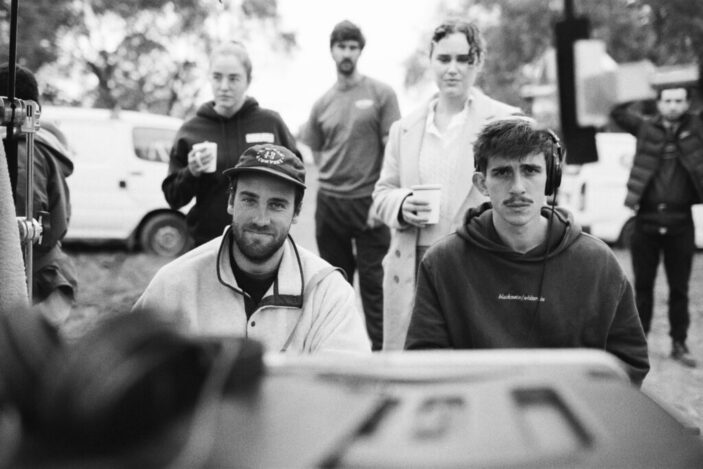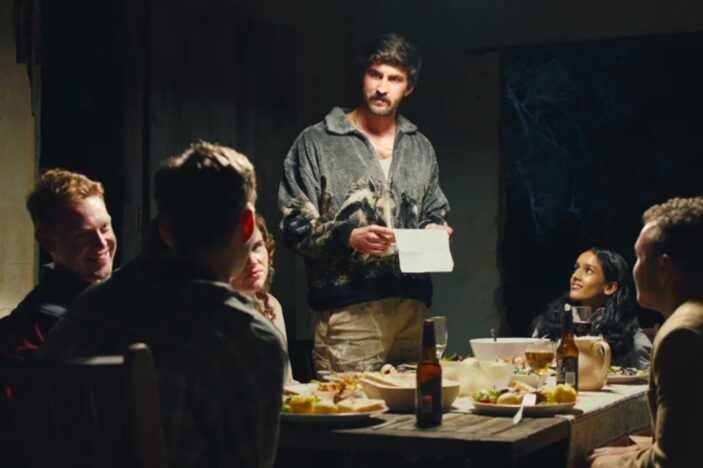
Described in our review as “visceral and feral” (you can read the full review here), Birdeater is a film that embraces what it is to be truly horrific, leaning into the brutality of psychological and emotional abuse.
Following acclaimed runs at such festivals as last year’s Sydney Film Festival, Melbourne International Film Festival and the Brisbane International Film Festival, before unnerving international audiences at this year’s SXSW Film & TV Festival, Jack Clark and Jim Weir‘s thriller – which tells of when a bride-to-be is invited to her fiancé’s bachelor party, and the feral turn the night takes when uncomfortable details about their relationship are exposed – is set to replicate its terror for the general masses when it releases in Australian theatres this week.
To coincide with its release, Peter Gray spoke with the directing duo about where their idea stemmed from, how they found it played to international audiences, and what story additives they left on the cutting room floor.
You’ve probably been asked this question multiple times before, but I have to do right by the readers, so how did the idea of Birdeater come about? Was this something that one of you thought of and then collaborated? Or were ideas fused together?
Jack Clark: We wanted to make a feature as soon as we could. We directed shorts individually before, but we started developing this idea about a couple with separation anxiety, and we wanted to figure out a way to separate them. That’s where the Bucks party premise came in. As soon as those two things sort of married, we realised that it created this bizarre genre mix, which excited us, because we’re very into that. We’re into strange combinations of genres that keep an audience on their toes.
Then we had an opportunity to work with this new Sydney company, Breathless Films, to develop (Birdeater) really quickly. We were able to dive into it almost immediately, which was a huge blessing. But it was a quick process in terms of figuring out what we wanted to do, and then just going for it. It was nice because if Breathless (Films) hadn’t come around, we probably would have mulled over what our first feature should be for a long time.
One of the things I really loved about the film is the way it explores masculinity. It does so in a way that seems to be catering to a “city audience”, so to speak, but it has that bush larrikin mentality. Was that exploration intentional in exposing audiences to a certain type of archetype?
Jim Weir: Yeah. Largely it was because we just all grew up in the city. But we noticed on weekends away, you just go to the outback and you take on this persona of the bush larrikin. It’s this archetype that we just have in our national history. We think of it as the “Australian man”, and it has overstayed its welcome. It’s no longer really compatible with contemporary gender politics. He’s still around, but we don’t know what to do with that guy. I think we were largely interested in interrogating that.
The Bucks party and that situation slipping out of control is something that feels quite universal. The “Paranoia” game that’s played, is that one you have personally partaken in before?
Jim Weir: We have both personally played Paranoia with our friends, yeah.
Jack Clark: But it has gone quite badly at times (laughs).
Jim Weir: Yeah, it’s not particularly fun. I think the idea of Paranoia was one that we’d been kicking around for a while. As soon as we started talking about this awful game, we thought it would make a great set piece. It seemed to naturally fit in once we started developing Birdeater. In terms of personally, most of my weekends away don’t go this far. Birdeater is much worse than anything I’ve experienced.
Jack Clark: In terms of choosing the Bucks party, I think it was because we knew as soon as we made that choice to frame it with this group of guys, and their intent to get really drunk, really messed up, that concept would just have differing levels of fear. Some people can think of that scenario and think it’s going to be immediately funny. For others, it’s an inherently threatening place to be. You don’t have to do much. It’s a Bucks party in the bush, you know? Audiences will be pretty torn as to whether or not they want to be there at all. And that’s an exciting place to set a movie.
Did you find the SXSW audience, who this film played to earlier in the year, responded differently to what you’ve found with Australian audiences?
Jack Clark: We thought they would. We thought it would be a night and day (reaction). It took them a little longer to warm up to the humour. There’s a certain point in the film, which was kind of by design, that Australian audiences just kind of automatically start laughing. But the American audiences would just take a little longer to figure out they were allowed to laugh at things. But they really took to it. We found they actually went to very personal places in the Q&A too. We had a lot of people standing up and not really asking questions, just kind of using it as a forum to talk about their history of traumatic relationships. It was nice to see people engaging with the film on that level.

On the mention of relating to the film personally, I really took to the characterisation of Dylan. Right off the bat it’s such a wonderfully unhinged turn from Ben Hunter, but it graduates to something more tender when we see his interaction with the character of Murph, and that question of his sexuality comes into play. It was quite a beautiful, inclusive moment.
Jack Clark: 100% Dylan was written as a queer character. You read that moment, but we also really liked Murph kind of reject Dylan in that moment too, as well as then physically touch him after. It felt like something that straight men wouldn’t do afterwards. It was a combination of things that we felt added a lot to that scene. But it was intentional, and Ben really liked the multifaceted aspect of that character as well.
I wouldn’t be able to pass up talking about the “Lady Lazarus” scene either. The film was already tense up to that point, but I felt like it just went to a whole other level following that. I have to know the origins of that sequence.
Jack Clark: I’ll be honest, that was one of the easiest things for us to conceptually come up with, because as soon as we thought of the Bucks party, we thought of how we were going to deal with the presence of a sex worker – whether it happens or not. That was the first kind of implication to us that there was going to be an uncomfortable experience. Or at least the uncomfortable anticipation of a sex worker, or dancer, or stripper. It was almost the first thing that we thought was going to have to fit into the structure somewhere.
Was there anything in the original script that didn’t make the final cut?
Jack Clark: Actually there was something. There was a detail about the production design that we just didn’t have the time to include. We wanted inside Lady Lazarus’ van to have this really childish wallpaper. Like pin-up images from Big W or K-Mart brochures, like the lingerie sections. Those first images of semi-sexualised women that young boys would see. It would just be very, very uncomfortable. But we never really had the chance to get to it.
Jim Weir: I think we realised we didn’t want the camera to be that close.
Birdeater is screening in Australian theatres from July 18th, 2024.
